Launched September 8, 2019
Online/ Silver Center for the Arts, Lobby Gallery
Co-curated by Maria Sanders
Photographs from this exhibition are for sale. Prices start at $50. To inquire about purchasing a piece, please email Maria Sanders at masanders1@plymouth.edu
Dr. Maria Sanders, a philosophy professor at Plymouth State University, was awarded a sabbatical in Fall 2019 to travel with her teenage son Brandon to all 50 states in the United States exploring how people have converted spaces into meaningful places. From natural preserves to repurposed structures, Dr. Sanders visited a plethora of places intentionally engaging in a variety of experiences challenging herself to philosophically reflect upon the relevance of place in living full and flourishing lives.

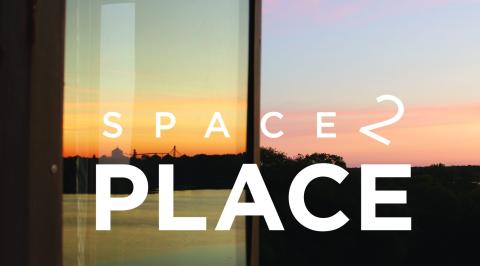
Photographs from this exhibition are for sale. Prices start at $50. To inquire about purchasing a piece, please email Maria Sanders at masanders1@plymouth.eduHighlights from this six-month journey were captured in Dr. Sanders’ blog,
Exploring US
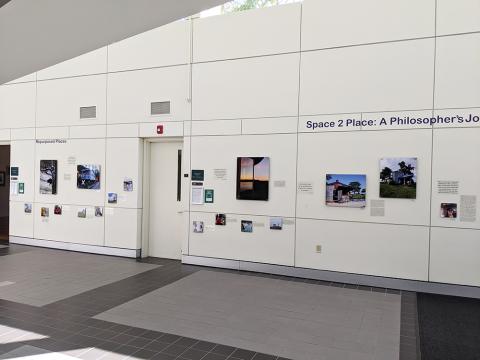

The Has Bin and the Grain Bin Bar are both the result of someone’s vision to repurpose a grain bin that had outlived its original function. Repurposing these bins rather than discarding them is not only better for our environment, but it also creates new places that provide an opportunity for the development of individual and social memories. We had rich experiences at both places resulting in not only pleasant but rather complex memories. The Has Bin is a dwelling that was created from a grain bin with a multi-generational history with the family responsible for its conversion. As the family’s stories were shared alongside a dose of Americana history regarding grain bins as useful objects in agricultural places, my personal experience of staying in the Has Bin with my son naturally incorporated the experiences with the local families and the stories they shared. Likewise, my stay in the converted Corn Crib in Nebraska offered an equally rich experience. I was invited to join the family at the Grain Bin Bar which was again a repurposed grain bin that now offers a central gathering place for family and friends.
Memories are often considered personal to particular individuals, but there are also social memories. Many social memories are unsupported and therefore eventually forgotten, but some social memories are commemorated through the preservation or production of places such as museums, monuments, and national registries granting historical status deeming particular buildings as worthy of remembrance. The usage of place-memory can effectively perpetuate public memories of past experiences. Reading about Henry Ford’s Model T in a history book does not carry the same impact as walking the streets of Greenville Village at The Henry Ford indoor and outdoor museum in Dearborn, Michigan. At Greenville Village, visitors can ride in a Model T in a reconstructed village designed to take them on a place-based journey through 300 years of American history. Likewise, reading one of Laura Ingalls Wilder’s stories about life on the open prairie may produce an educational look into a unique time period in America’s history, but reading that same book while spending the evening in a covered wagon on the Homestead property of Laura Ingalls Wilder in De Smet, South Dakota takes the experience to a whole new level.
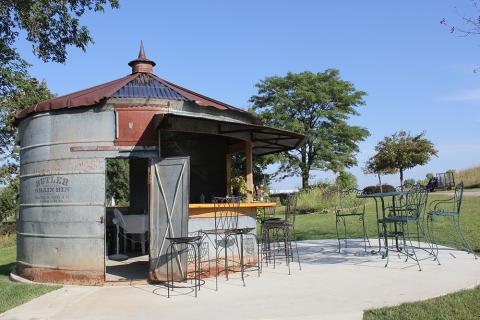
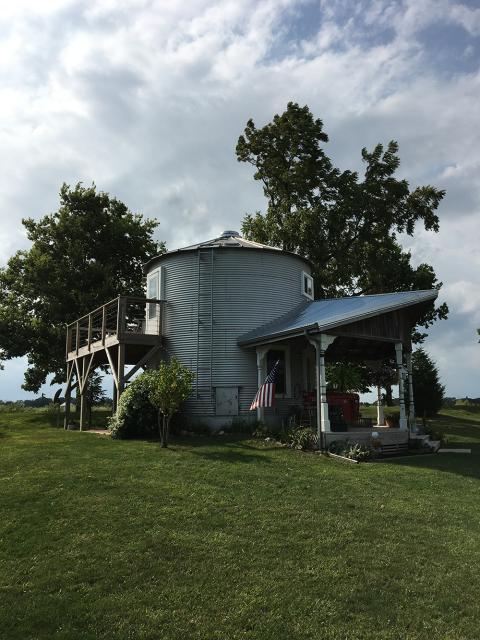
Riding the Rails and A Shadow from the Past were photographed on the same property in Clyde, North Carolina where an intentional effort has been made to create a “sense of place” by Buffalo Creek Vacations. Some places are said to have a sense of place because they offer unique characteristics that make the place feel special. The Seaboard Coastline Caboose is only one unique feature at this property. There are several other cabooses, elaborate miniature train exhibition, a herd of bison, multiple other animals, and the list goes on. All of these features work together giving the place a unique character reminiscent of a time gone by.
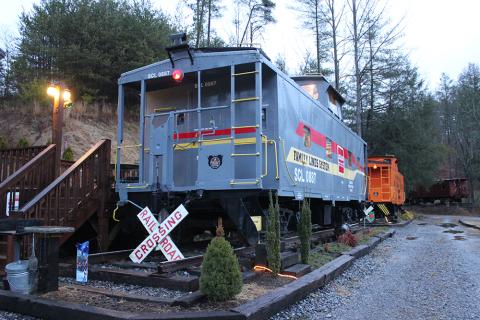

Natural Reflections captures a gorgeous sunset reflecting in the man-made silo now converted into multiple dwelling spaces. The layers of place present in this image elicit philosophical reflection on the various aspects of individual place making. Given the direct impact place has on personal identity, people often intentionally create places to discover and advance their personal identity. When a student moves into a college dorm room, the transformation of the room into that student’s personal space begins immediately. A lack of fit between a person and a place is felt physically and mentally. Places often mark important times and moments in our lives. Revisiting such places can awaken memories so vivid that time rewinds. It has the power to forge collective connections or to leave the individual feeling isolated and alone. Place is more than a detached backdrop for life’s activities; instead, place is intricately interwoven into every action and every experience. It is not only where we live, but how we live and who we become.

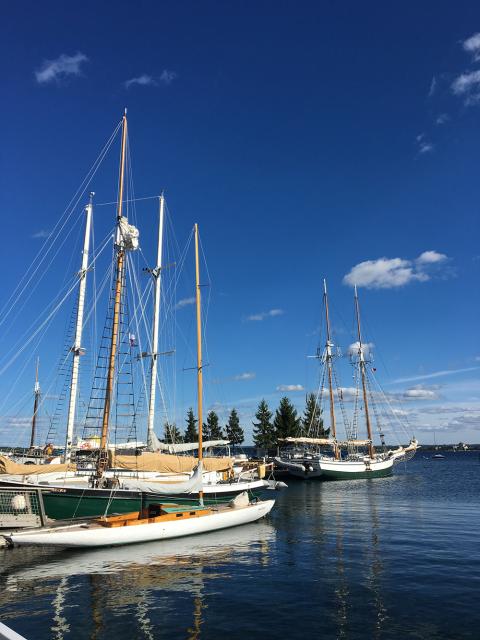
Manitou Tall Ship features the majestic tall ship that sails daily out of Traverse City, Michigan. Built in 1983, the Manitou’s hull was constructed in Portsmouth, New Hampshire and finished in Lake Champlain, Vermont, Today, the Traverse Tall Ship Company offers a variety of cruises aboard the Manitou from a couple of hours in length to several days.
While sailing aboard the Manitou, I was reminded of the 20th century French philosopher, Michael Foucault. Foucault recognized that how places are designed impacts us socially and politically. Foucault challenged the possibility of objective knowledge. He believed objective knowledge was the result of social and political factors, not the result of objective truth. Foucault recognized that places have multiple uses and dimensions. He coined the term “heterotopia” to allow for multiple descriptions of a place. Unlike “utopia” which is a singular, perfect (albeit imaginary) place, heterotopias are dynamic and multi-layered. They are not permanent or fixed. A tent or a boat is a “place” but that “place” is movable. Foucault saw these places, like the Tall Ship Manitou, as marginal spaces where human beings can construct a persona or public image that is not necessarily aligned with their true self. Foucault wanted to draw attention to urban planning and the choices that are made by those in positions of power when designing shared places. The extent to which multiple uses for a place can emerge relies in part on mental faculties such as imagination, but places that are designed to be constrained or difficult to access limit the number of possible usages by its very design. It is therefore important to consciously consider whether the shared places in our towns and cities allow for a multiplicity of experiences. Do these places have the social and political flexibility to allow for personal connection and genuine human expression?
Creative Places
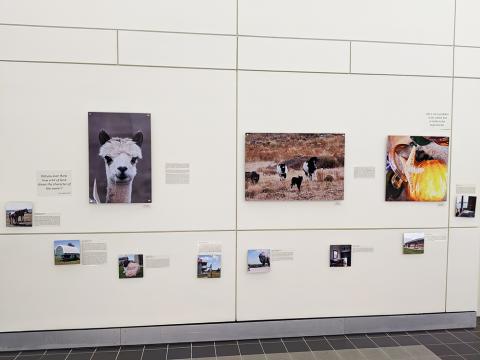
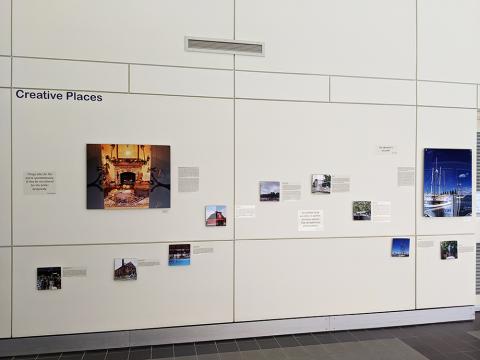
Imagination’s Gateway welcomes guests into a fictional world brought to life. Hobbit’s Dream is more than a place to spend a night or two. It is an experience. As guests walk down the winding path and pass under the canopy of vines to enter through the gate to the Hobbit Hole, they are carried to a magical place that transforms current reality into the imaginative world of J.R.R. Tolkien’s The Hobbit. The details in and around the Hobbit Hole pay homage to all five senses. Guests are invited to enjoy a cup of coffee in a Hobbit Mug or glass of wine with some homemade seed bread while listening to the sounds of natures surrounded by the scent of herbs. Hand forged swords, a map to Middle Earth, and even a miner’s helmet grace the walls. There are costumes for the more adventurous and workshops on carving walking sticks, making wooden pipes, and crafting straw brooms for those interested in tapping into their inner artisan.
Hobbit’s Dream is truly a feast for the senses. Beyond the seamlessly endless collection of visual treasures adorning every nook and cranny of the Hobbit hole, guests can experience the feel of the cold steel of a forged sword in their hand or the soft fibers of Gandalf’s cloak around their shoulders while enjoying the scent and taste of freshly baked Hobbit-sized seed bread listening to the soft symphony of nature outside. The Irish philosopher, George Berkeley, was the first to claim that all of sense experience is “voluminous”, that is associated with some space or place. This did not lead Berkeley to deeply delve into attempting to understand the realities of these spaces and places; instead, he denied the existence of metaphysical substance claiming that the things we sense are ideas formed by our minds that come from God’s will. Berkeley believed such ideas could not come from human will since humans can never fully perceive an object. Consider a classroom of art students sketching a basket of fruit. If there are 10 students in the class, the result will be 10 different drawings, since each student is seeing the basket of fruit from a particular perspective. None of the drawings fully capture the actual basket of fruit. This is a simplified way of viewing the insurmountable challenge humans face when using their senses to experience the world around them.

Places are dynamic entities, constantly changing and evolving. Unlike objects such as trains and automobiles that emerge from a factory as finished products, places are never finished. They constantly emerge as a result of social, cultural, and even mundane practices. Kaleidoscope Living and Running Free were both photographed at the Mermaid Cottage in Del Norte, Colorado. Kaleidoscope is a sliver of an isolated perspective from inside the Mermaid Cottage that leaves much of the individual experience to the imagination. Running Free freezes a moment of energy and motion, removing it in time and place from the original occurrence. As the two miniature horses chased the black Labrador across the open prairie towards the Mermaid Cottage only to lose interest in their game of tag upon discovering the arrival of new visitors to the Cottage, one could sense a fluidity of place as the activities in that place shifted.
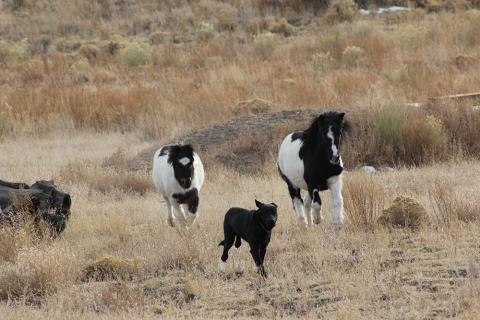

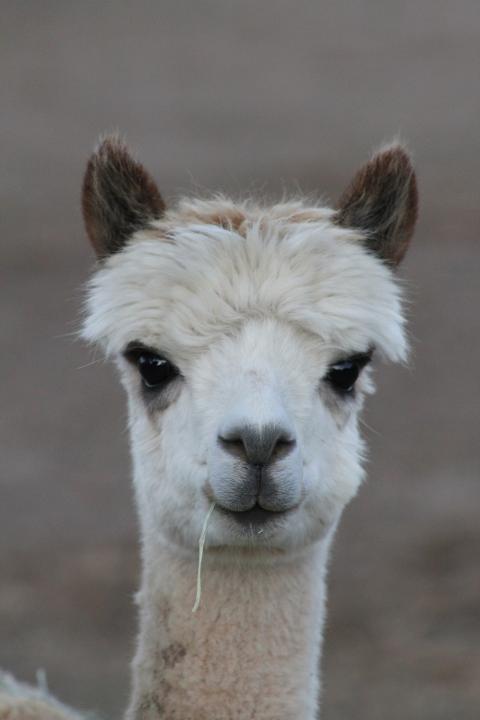
Playful Wonder captures an alpaca at Seven Stars Alpaca Ranch who had just finished his evening meal. During our stay at the Ranch, we were invited to assist with herding the alpacas between corals and with feeding the llamas and alpaca. For the most part, these routines were like choregraphed dances where the alpacas clearly new their steps, but one evening, four of the alpacas broke away from the main herd and frolicked for nearly an hour before we were successful in returning them to the chorus line. My son learned to drive a Polaris Ranger and became our driver for the ranch tour. By participating in the daily rituals of the ranch, the Seven Stars Alpaca Ranch quickly became a meaningful place with experienced stories. This is precisely what the Ancient Greeks meant by the term “Chora.” We arrived as guests and left as friends.
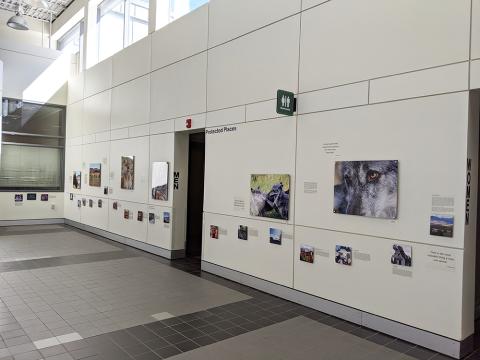
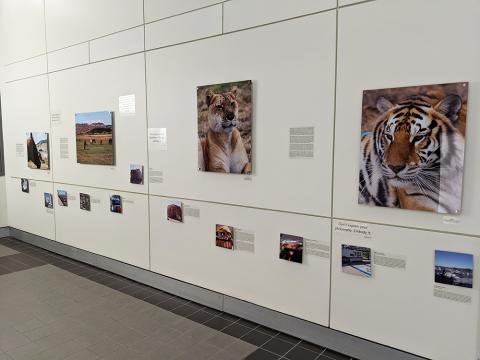
Contemplation, Compassion, and Shadow of Submission captures wolves from a pack of cousin wolves at Wolf Creek Habitat. Wolves mostly live in packs led by an alpha male and alpha female. There are male and female hierarchies that are interdependent and maintained with constant displays of dominance and submission. This structure influences everything that occurs in the pack, from feeding to breeding. A wolf pack inhabits a place and moves through spaces similar to how human communities interact with the places they inhabit. There are power structures imposed upon place as well as derived from the very design of the place occupied. It is not uncommon for individuals who are new to a place to feel as an “outsider” until they are welcomed into the dominant community using that place.
Many researchers have focused on the connections occurring between and among members of a community, but interwoven into these connections are layers of complex connections with place. An individual may feel varying connections with the same place depending upon the social and political dynamics of the communities residing in that place. In this way, an individual’s connection with place is a complex, layered relationship.
Predator captures a Bengal tiger who was rescued and is currently living out the remainder of his natural life at the Turpentine Creek Wildlife Refuge in Eureka Springs, Arkansas. Bengal tigers are the largest members of the cat family and have a yellow to light orange coat with black or dark brown stripes. In the wild they live in India, but the population of Bengal tigers in the wild has depleted so rapidly in the 20th century that three of the eight tiger subspecies have become extinct. There are now fewer tigers in the wild than in captivity.
Liger Pride displays a liger enjoying the morning sun. Ligers are intentionally bred in captivity largely for the entertainment industry seeking a novel attraction to increase profits. A Liger has a Lion father and a Tiger mother. These are not classified as a separate species because a Liger would never occur naturally in the wild. Not only would they never naturally meet in the wild since Lions are from Africa and Tigers are from Asia, but male Ligers are always sterile so it is impossible for Ligers to reproduce as a species.
One aspect all of the big cats at the Turpentine Creek Wildlife Refuge have in common is they have been displaced from their natural habitat. Whether bred or captured for the entertainment industry or for an individual’s personal desire to attempt to convert a predator into a pet, all of these animals still possess their predatory instincts even though they have been displaced from the wild. As a result, the consequences can be deadly for their handlers.
Likewise, displacement impacts human beings who are forced to leave their homes or towns as a result of natural disasters or human warfare. Globalization is also having an interesting impact on the displacement of migrant workers and other individuals on the move searching for employment, resulting all too often in a distortion of the motives and experiences of people living mobile lives.


Forever Free shows a sample of a herd of mustangs living on the 11,000-acre Black Hills Wild Horse Sanctuary. The sanctuary was created in 1988 to preserve the natural habitat of wild horses while providing a place for unwanted American Mustangs to live out their lives in freedom. Resilience showcases the resilient spirit of the American mustang. Two centuries ago, there were millions of free roaming, wild mustangs in the United States. Today, most of the wild horses in the United States live on public lands under the responsibility of the Bureau of Land Management or they are on private ranches and wildlife refuges.
A guide at Black Hills Wild Horse Sanctuary shared a story of a rescued mustang that preferred the company of the neighbor’s cow over the company of the other wild horses. As a result, this particular horse would jump the perimeter fence each evening and the neighbor would find the horse grazing with his cow. After returning the horse several times, the Sanctuary’s founder Dayton O’Hyde, told the neighbor he could keep the mustang, reasoning that the Sanctuary was created to provide the wild horses a place where they could be ‘forever free’. It was never intended to be a prison for the horses, so if this horse would rather live outside of the Sanctuary, then Dayton would respect the horse’s wishes.
This story raises an interesting philosophical question as to whether the wild horses at the Sanctuary are free. There is a perimeter fence around the 11,000-acre property which is there in large part to protect the horses. The horses are permitted to freely roam the property, however, so some may eventually discover the fence. Of those that eventually discover the fence, some may desire to go beyond the fence, while others may be content to remain within the fenced area. Are the horses free?
The British philosopher John Locke proposed a similar thought experiment where he raised questions of free will and voluntary action. Locke challenges us to assume a man is kidnapped while he sleeps and locked in a room with a dear friend he has not seen in years. The kidnapped man has no desire to leave the room as he is enjoying the company of his friend. Is the man free?

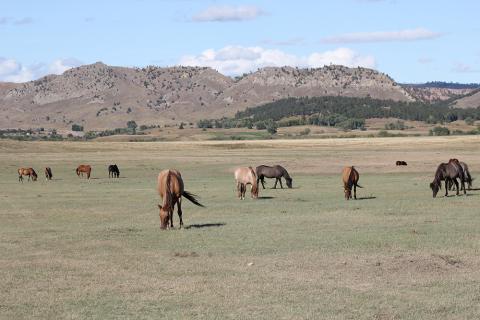
All too often that which is most familiar to us is the easiest to overlook and take for granted. The COVID-19 pandemic disrupted “common place” world-wide. People around the world scrambled to regain a sense of place. As places of work, education, and entertainment shifted dramatically and the place we call home assumed the functionalities previous rooted in distinct localities of businesses, schools, and concert halls; new places emerged evidencing that experience impacts place as much as place impacts experience.
Winter Wonder captures a bull elk during an unexpected snowstorm in Yellowstone National Park, and Nostalgia shows a large bison enjoying the prairie grass adjacent to Old Faithful, the most popular geyser in the park. Prior to European settlements in the United States, both elk and bison were a common sight. Prior to the 1800s, it is estimated that 10 million elk lived in every state except Alaska and Florida, and 30 million bison roamed the continent. By the late 1800s there were less than 1,000 bison and no remaining native elk. Restoration efforts have resulted in approximately 350,000 bison and 1 million elk living in North America today. Keeping this in perspective, those numbers represent 1% of the former bison population and 10% of the pre-1800s elk population. Current bison and elk herds have been reintroduced into states where their ancestors roamed, but the place itself has changed. Attempts to recapture a place from the past can only be met with the success of creating something anew albeit encased by nostalgic memories misplaced in current realities.
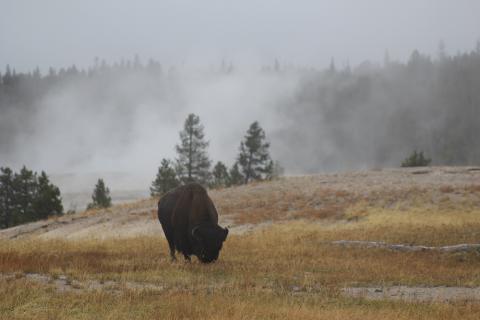
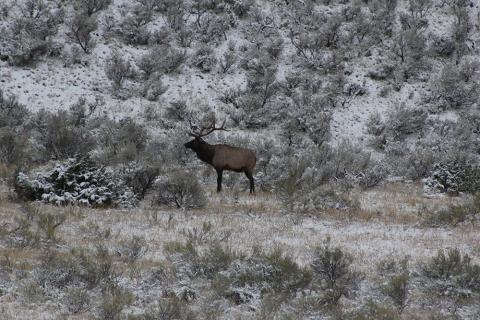
Natural Places
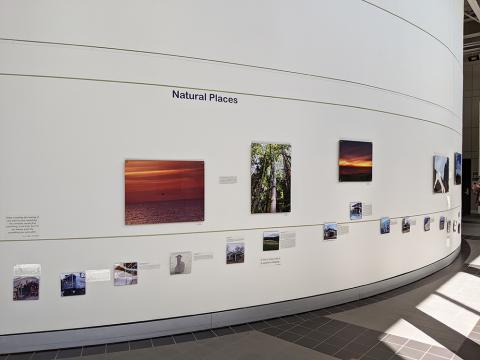

The Ancient Chinese concept of yin-yang recognizes the interconnectedness and interdependency of seemingly opposite forces. In the natural world, what appears to be contradictory may actually be complimentary. The relational concept of yin-yang influences the philosophies of Taoism and Confucianism, though their interpretations vary. In Taoism, the duality of yin-yang is viewed as merely a perception whereas yin-yang in reality is unified and indivisible. Interpretations of Confucianism, however, do seem to view the duality of yin-yang as more than a perception. In fact, several philosophies based upon Confucianism apply a moral dimension when a lack of balance occurs between yin and yang.
Yin Yang evidences the interrelatedness of two Hawaiian lizards in what may appear as contrary positions, but it is this very positioning that balances and stabilizes the leaf for both lizards. In similar, though possible less visually direct ways, various feminine elements of nature are thought to balance masculine elements of nature. Yin is associated with the feminine elements such as water, darkness, and tranquility; and Yang with the masculine elements of light, heat, and fire. Chinese medicine maintains achieving balance within the mind and body and their interactions with nature is the formula for lasting health and wellness.
Relaxing on the deck of The Corn Crib enjoying nature’s wondrous brushstrokes across the evening sky in Nebraska was the perfect setting for a bit of philosophical reflection. As seen in Nature’s Brush the hues of blue and purple were particularly vibrant as the fiery sun departed behind the tree line. The lake was calm, reflecting the sky’s hues back onto itself… or so it appeared.
The German philosopher, Immanuel Kant, distinguished between the raw materials that constitute our experience and the organizing mental processes our mind imposes upon those materials. In other words, Kant held that humans were not capable of experiencing the world as it is. Instead, we experience the world through our cognitive filters which organize raw sense data into something meaningful in our minds. Taken a step further, social and cultural pressures can cause us to privilege some aspects of raw sense data over others. It becomes simpler to see what we expect to see rather than to look deeply.
Whether standing at the base of a towering redwood as seen in Giant Wonder or gazing quietly at a fiery sunset in Del Norte as in Crimson Sky, attempting to perceive the actual raw sense data while minimizing or challenging our cognitive filters can be quite the meditative activity.
Frederick Nietzsche, the German philosopher best known for his existentialism also recognized a connection between nature and our bodies and minds in his final work Ecce Homo. As such, Nietzsche valued the importance of place. He realized place is highly impactful on our quality of life, and was particularly fond of dry air and clear skies.
Intentionally selecting and/or creating the physical environments within which we feel a natural affinity is essential for living a full and flourishing life. The places where we live, work, and spend our leisure must be a good fit for our health and well-being if we are to thrive in our existence. The farmer cares about the soil, water, and air around their crops in order to maximize excellent growth of those crops. Likewise, caring about our environments provides an appropriate place for our physical, mental, and spiritual growth.
Nature’s Glimpse was taken at an intimate beach on Hawaii’s Big Island near the jungles of Pahoa. At the island’s edge, rich green vegetation outlines the rocky lava beach and crashing ocean waves. Several months later, a calmer beach setting was captured in Shimmering Glory on the shorelines of Virginia Beach. Even though the individual features of these two beaches were quite distinct, they shared a similar holistic feel of serenity. Morning Hope features the morning sun emerging after a storming evening on Myrtle Beach, creating a sensation of anticipation and hope for the new day.
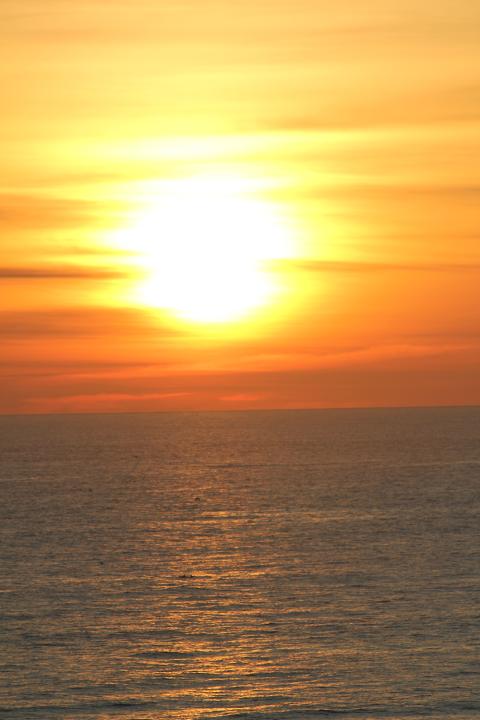
Sunset Shimmering Glory, Virginia Beach, Virginia
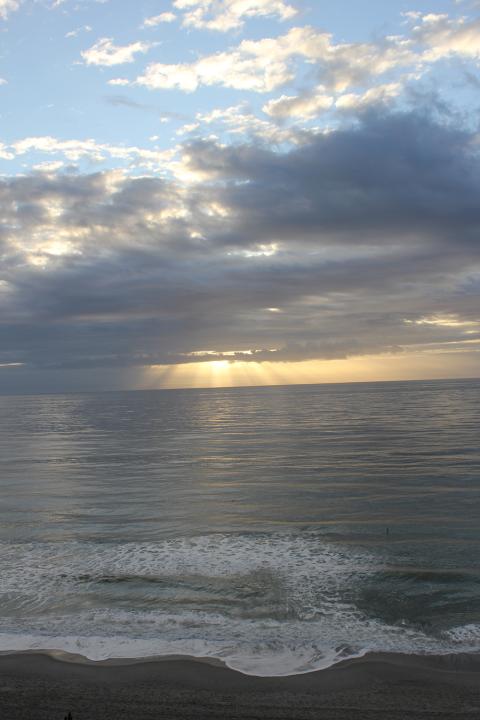
Morning Hope, Myrtle Beach, South Carolina
Place identity is a significant concept in urban planning and landscape architecture recognizing the impact places and their designs have on developing the identities of the people who inhabit and use those places. During our travels, I often found myself reflecting upon the places between our points of destination. The highway itself is a place; one with varying character depending upon its location, climate, and common usage. On the Road reveals a place quite distinct from the place in Montana featured in Through the Pines. Though often overlooked, the physical environments we regularly and consistently move through to arrive at our places of destination influence our self-perceptions and personal identities in much the same way as the places of destination.



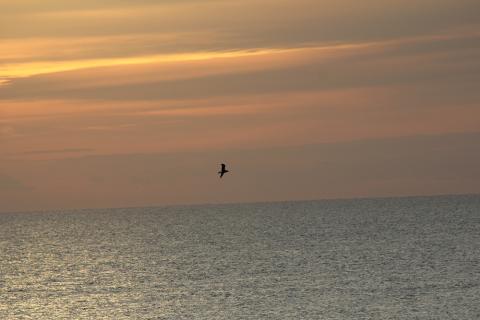
The phenomenologist, Maurice Merleau-Ponty, recognized that human beings transform the physical world by merely being present. What was once an open field, is not a place of food production, and what was once a secluded beach is now a retreat. Jacob’s Ladder shows a grove of bamboo that could easily serve as a hiding place for quiet escape, and Misty Flight offers the serene setting for bodily restoration and mental rehabilitation. A more dramatic place is found in Heaven’s Blaze where a stagnant or bored soul can find rejuvenation. Merleau-Ponty wrote much about the interplay between the world’s flesh and our own. The natural world offers an array of shelters and hiding places to feed our ever-changing needs for physical, social and emotional security.
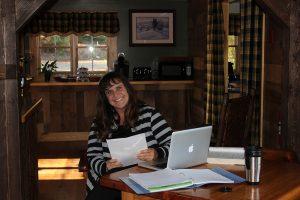
Having journeyed to 49* of the 50 states in the United States, it is now time to gather and organize the photos, interviews, film, and philosophical reflections. The Exploring US blog that followed our travels served as a resource for this art exhibition and will soon be published as a book. The film of the many places visited during this journey and the on-site interviews conducted with the masterminds behind these places is currently being edited into 30-minute episodes for The Looking Glass television show with an anticipated airing to begin January 2021.
Highlights from the Space 2 Place Exhibition along with lessons learned during this philosophical journey will supply talking points for an upcoming Podcast on The Place We Call Home scheduled to begin December 2020. There will also be a 6-part audio series on People and Places scheduled to air on Philosophy 4 Life Radio on WPCR-Plymouth, 91.7FM during the months of February and March of 2021.
*Unfortunately our cruise to Alaska was cancelled due to the COVID-19 global pandemic. Plans to include Alaska may be temporarily on hold, but once the pandemic passes, a deep dive into the majestic places of Alaska will be a priority.
Download a .pdf map of places visited










